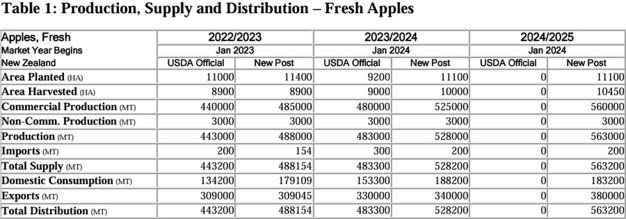New Zealand's apple-planted area in the 2024/2025 market year (MY) is forecast to increase substantially to 11,100 hectares (ha) from the damaged area panted resulting from Cyclone Gabrielle in February 2023. The apple sector sustained damages due to large-scale floodwaters, silt, debris, wind, and surface flooding in the primary apple-growing regions of Hawkes Bay and Gisborne. Although the recovery from the Cyclone damage is underway, on-farm inflation and debt servicing continue to put cost pressure on the growth of the industry.

FAS/Wellington forecasts apple production in the 2024/2025 MY to be 560,000 metric tons (MT). This is representative of an optimistic weather outlook, the implementation of farm system innovations, and the growing availability of seasonal labor. In addition, hectares planted in recent years have reached maturity and achieved higher yields.
FAS/Wellington also forecasts strong exports in the 2024/2025 MY at 380,000 MT, which if realized would be the highest since 2020. Export priorities are anticipated to continue to focus on Asian markets such as Vietnam and China, as well as the United States and the United Kingdom, in the foreseeable future. India is projected to be a growing market for New Zealand exporters, as apple consumption continues to rise as the population grows and healthier foods are in demand.
From January to September 2023/2024 MY, exports are tracking over 10 percent higher than the previous year. After the first 8 months of the year, volumes have already exceeded the total of the previous year. Recent media has reported the potential prospects of the total annual revenue in the current market year exceeding NZ$1 billion (US$ 600 million), the highest ever annually.

Domestic demand for pears in New Zealand continues to outstrip domestic supply. As a result, New Zealand imports fresh pears to meet its market demand annually.
New Zealand ranks as one of the world's top ten largest apple exporters, with a climate and soils making it well-suited for growing apples and pears. Key growing regions such as Hawke's Bay, Tasman, and Central Otago have ideal conditions for growing apples, such as sufficient winter chilling, warm springs, long sunshine hours in summer, and dry growing areas. These areas also have reliable water resources to irrigate orchards, and as a result, almost all commercial orchards rely on irrigation. New Zealand also has well-established ports close to its apple and pear regions. The harvest season starts in January and finishes in June, with peak harvest for apples from March to May. Figure 1 shows the distribution of the country's apple and pear growing areas, mainly in the Hawke's Bay region (nearly two-thirds of New Zealand's trees).
To read the full report, click here.
For more information:
USDA
Tel: +1 (202) 720-2791
Email: [email protected]
www.usda.gov

